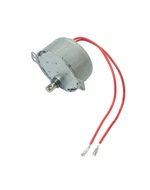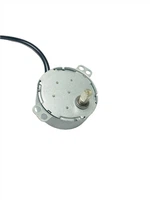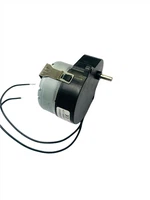AC Synchronous Motor
Why Choose Us
Our certifications
The Taiwan factory of our company has passed the ISO9002 international quality system certification, the American standard UL quality certification, the European standard CE /EMC quality certification, and the RoHs environmental protection certification.
Have import and export rights
The domestic company has the right to import and export, and its products are exported to more than 30 countries, and it provides the most suitable motors and related technologies according to the different needs of customers.
Our products
Our company produces synchronous motors, bidirectional synchronous motors, hysteresis motors (HTS), sparrow machine motors, and powder metallurgy gears. DC brushless motors, planetary geared motors (LED UV), push rod motors, DC motors, DC geared motors, high self-made products, and continuously improve equipment quality production management to achieve more rapid and flexible services.
Our service
In order to meet customer requirements for product diversification, the company also imports Japanese Mabuchi motors as an agent, and 100% of the goods are picked up by Mabuchi warehouses, and can be delivered in Hong Kong and domestically.
AC synchronous motors are a type of electric motor that operates on alternating current (AC) power. They are widely used in industrial, commercial, and residential applications for a variety of tasks, such as driving machinery, operating pumps, and powering appliances. In this article, we will take a closer look at AC synchronous motors, including how they work, their advantages, and their applications.
Ability To Maintain Constant Speed
One of the major advantages of the AC synchronous motor is its ability to maintain constant speed under various load conditions. It means these motors can maintain a constant speed even when the amount of load changes making it ideal for various industrial and commercial applications.The AC synchronous motor maintains a constant speed through the synchronization of the rotor and stator. When electrical current flows through the stator, it generates a magnetic field that interacts with the magnetic field produced by the rotor and causes the rotor to rotate at the same speed as of the magnetic field. This ensures a relationship between the stator and rotor, resulting in smooth and steady operation.
High Efficiency
Synchronous motors maintain a constant speed regardless of load. Unlike other motors, which may experience slip and loss of efficiency at partial load, AC synchronous motors operate at high efficiency across the entire operating range due to their ability to operate at synchronized speed.By adjusting the current supplied to the rotor, AC synchronous motors actively control their power factor. This allows them to correct any leading and lagging power factor resulting in optimizing efficiency and reducing energy losses.
High Starting Torque
AC Synchronous motors generate a significant amount of torque, allowing them to quickly accelerate heavy loads, without the need of any external starting source such as starters or frequency drives.The high starting torque ensures smooth and steady acceleration of the motor and minimizes the risk of wear and tear. It results in a longer life span and reduces maintenance costs.AC Synchronous motors with high starting torque are ideal for applications that require high inertia loads such as large fans, pumps, or conveyor belts. They can overcome the load easily and bring them to operate quickly and efficiently.
Long LifeSpan
The most significant advantage of AC synchronous motors is they have a long lifespan. Unlike other motors, AC synchronous motors have robust and durable construction, which allows them to operate in heavy loads and harsh environments conditions.Additionally, synchronous motors have a simple design with fewer moving parts, which reduces the chances of wear and tear and increases lifespan. Furthermore, AC synchronous motors have a high load-carrying capacity means they can handle heavy loads without affecting the performance and efficiency of the motor.
Types of AC Synchronous Motor
Single-Phase Motors
A type of induction motor, the single-phase motor has only a single stator, which creates currents in the rotor. These kinds of motors excel at low-power applications.
Polyphase Motors
These induction motors function similarly to single-phase motors, but they include two or more stator magnets, which allows them to function with higher power than single-phase motors.
Squirrel-Cage Motors
Another kind of induction motor, squirrel-cage motors derive their name from their cage-like stators studded with multiple magnets. While you cannot change the speed of these motors, they are relatively inexpensive, safe, easy to maintain, and energy efficient. Top manufacturers for squirrel-cage motors include General Electric, Siemens, Reliance, Toshiba, and Westinghouse.
Synchronous Motors
Unlike induction motors, synchronous motors move in sync with the current, which alternates. These motors will not have constant speed, but they do produce large amounts of power, making them ideal for industrial applications. However, they are also noisy, expensive, and big. The term “synchronous motors” is a catch-all phrase that includes multiple specific motor types, such as reluctance motors, hysteresis motors, and permanent-magnet motors.
Industrial Machinery
The synchronous motor plays a pivotal role in driving industrial machinery and its processes with precision and efficiency. These motors are commonly used in conveyor systems, mixers, extruders, machine tools, printing presses, and packaging machinery.Synchronous motors have the ability to maintain synchronization between the rotating magnetic field of the stator and the magnetic field of the rotor. It helps synchronous motors to provide precise speed control and ensure consistent processes with high-quality output.
Compressors
Synchronous motors are widely used in compressors due to their ability to provide high torque at low speed, precise speed control, and leading power factor.In compressors, synchronous motors drive the compression mechanism, to increase the pressure of gases and air in various applications such as refrigerators, air conditioners, and industrial machinery.These motors allow precise control over the rotational speed of the compressors and ensure efficient operation by maintaining synchronization with the power supply. It helps compressors to operate at the desired compression ratio and ensure efficient performance with minimizing energy consumption.


Pumps
Synchronous motors are the integral component of the pump system. These motors drive the rotating impeller or rotor of pumps to maintain fluid flow in applications.Synchronous motors offer several advantages to pump systems. Firstly, synchronous motors provide high torque at low speeds and ensure efficient start-up operation, especially when the pump needs to overcome the initial resistance from the lower level.Additionally, synchronous motors offer precise speed control and allow the pumps to regulate the flow of liquid accurately to applications. It helps pumps to offer reliable performance and ensure energy efficiency in various load conditions.
HVAC System
Synchronous motors are the essential components in HVAC systems by providing precise control and efficient operation in various applications. These motors power the various components of HVAC systems such as fans, compressors, and dampers.In fans of HVAC systems, synchronous motors ensure precise speed control for optimal speed regulation, temperature, and humidity control in residential and commercial areas. Similarly in compressors, synchronous motors ensure efficient heating and cooling processes and contribute to temperature regulation and energy efficiency in various environmental conditions.
Components of AC Synchronous Motor
Stator
It is the stationary part of the motor. It consists of a stack of thin, insulated laminated sheets and other magnetic materials. These laminations are stacked to form the core of the stator. The core of the stator consists of coils of wire wound around the slots and form the winding of the motor. When AC is supplied through this winding, it produces a magnetic field to rotate the rotor.
Rotor
It is the rotating part of the motor. It consists of steel lamination, copper conductors, and permanent magnets. When AC is supplied through the winding of the stator, it generates the magnetic field, then the rotor interacts with the magnetic field and rotates the motor at a synchronized speed.
Exciter
It is a crucial component of a synchronous motor. It is responsible for maintaining the synchronous speed of the motor. Adjusting the phase of direct current (DC) supplies to the rotor, ensures that the rotors rotate at the same speed as stator winding. It helps the motor to rotate at its constant speed and to maintain its stability.
Bearing
It plays a critical role in a synchronous motor. It provides support to the rotor shaft to maintain its position and allows it to rotate freely. There are 3 types of bearings such as sleeve bearings, roller bearings, and ball bearings.Sleeve bearings made up of bronze allow smooth rotation of the rotor by providing low friction. Roller bearings use cylindrical and tapper rollers to reduce friction and handle high radial loads. Ball bearing uses balls to minimize friction.
How to Choose AC Synchronous Motor
Types
AC motors are mainly divided into induction motors and synchronous motors, of which induction motors are relatively simple, low-cost, and maintenance-free, but are limited to constant speed applications. Synchronous motors are more complex, but can provide better speed and torque control for variable speed drives. Permanent magnet synchronous motors provide the best performance for many variable speed applications.
Sizes
Oversizing the motor reduces efficiency and increases cost. Undersizing the motor can overheat and cause premature failure. You need to consider current and future load requirements to select a motor with the appropriate power rating.
Applications
For variable speed applications, there are two most common speed control methods: voltage/frequency control and vector control. Voltage/frequency control is simpler and less expensive, but it only provides about 50% of the rated torque at half speed. Vector control is more advanced and uses variable frequency drive (VFD) technology to control three-phase AC motors, controlling the motor's output by adjusting the output frequency, amplitude, and angle of the VFD output voltage.
Use Environment
In addition, the use environment needs to be considered. Open motors are only suitable for use in dry and clean environments. If the environment is humid, they are easily damaged. Fully enclosed motors are mostly suitable for dusty and humid environments. Due to the fully enclosed design, such motors are not easily damaged by the environment during use.
Insulation Resistance Testing
Using applied DC voltages as specified by IEEE 43-2000, a potential is placed between the stator windings and ground. This measures only direct faults between the stator windings and the stator frame. Is also performed through the slip rings on a brush-type machine.
Polarization Index
This is a 10-minute to 1-minute ratio of insulation resistance. This has been traditionally used as a method to gauge the condition of the insulation between the stator windings and frame. As with insulation resistance testing, this can also be performed through the slip rings on a brush-type machine. As stated in IEEE 43-2000, this test method is only truly valid on pre-1970 insulation systems.
High Potential Testing
Most common on large machines is DC high potential testing which is performed at a value of twice the motor nameplate voltage plus 1000 volts, times the square root of 3. On an existing insulation system, this value is often reduced to 75% of the potential voltage. This test highly stresses the insulation system and is potentially damaging (per IEEE Std 's 388 and 389). This type of test should NEVER be applied to the rotor windings of a synchronous motor.
Surge Comparison Testing
Evaluates the turn-to-turn condition of the stator only by comparing the waveforms of two windings when a fast rise time pulse of twice the voltage plus 1000 volts. If there are correctable issues, such as contaminated windings, this test may damage the motor windings.
Partial Discharge Testing
This is a non-destructive test method that measures radio frequencies from discharges in voids within the insulation system of the motor windings. This is effective for trending on machines that are over 6.6 kV and only provides a brief warning from 4 kV.It does not detect any rotor faults.
Motor Current Signature Analysis
Was designed for rotor testing of induction motors.
Voltage Drop Test
Requires that the motor is disassembled. A 115 AC voltage is applied to the rotor windings and the voltage drop is measured with a voltmeter across each coil. If there is a short, the voltage drop will vary more than 3%.
How to Maintain AC Synchronous Motor
A quick visual inspection can reveal some important details about the electric motor. Take a look at its physical condition and record your observations. If the electric motor operates in a rugged environment, you will see signs of corrosion and dirt buildup on individual components. Observe the motor 's windings to detect any hint of overheating, such as a burnt odor. Ensure relays and contacts are dust-free and aren 't rusted. All these factors may cause an internal problem as the debris may pose a threat to the efficient performance of the equipment.
Regular maintenance checks help ensure that electric motors won 't experience inconsistencies or stop working abruptly. Look for signs of wear and tear; any hint of excessive wear leads to commutation problems with the motor. This means you need to change the brush in order to regain the integrity of the equipment 's function. Also keep a check on the commutator to ensure it doesn 't have any dents, grooves, or scratches. These rough spots indicate brush sparking. Additionally, inspect the motor mount, rotor, stator and belts thoroughly. Replace all worn out parts.
Once you have inspected the various machine components, you need to test the motor 's windings. This test helps you identify any anomalies or failures in the windings. If you see any burn marks or cracks or smell a burning odor, conduct a mandatory motor winding test. The test involves disassembling the motor to determine the abnormalities of the motor. If the windings are overheated, the chance of serious damage is higher. Rewinding the motor and testing the wind insulation, which reveals information on the resistance level, are also critical parts of the test.
Check the bearings for noise and vibration as they indicate potential problems, like poor lubrication, dirt buildup, and wear and tear. If the bearing 's housing is too hot to touch, it may mean the motor is getting overheated or there is an insufficient amount of grease. The maintenance requirements for bearings may vary, depending on where the equipment is situated. You need to be aware of the different kinds of bearings being used in the plant and what their repair requirements are.
Our Factory
Shenzhen Songgang Technology Industrial Co., Ltd. is a branch of Songgang International Group, headquartered in Hong Kong. It is a factory specializing in the production of various types of motors. There are factories in Taiwan and China to produce different types of motors.The Taiwan factory is the only metal gear synchronous motor professional manufacturer, adhering to the highest service level and best quality performance, serving domestic and foreign manufacturers. The domestic company has the right to import and export, and its products are exported to more than 30 countries, and it provides the most suitable motors and related technologies according to the different needs of customers.

certificate

















